The iPhone 5 Review
by Anand Lal Shimpi, Brian Klug & Vivek Gowri on October 16, 2012 11:33 AM EST- Posted in
- Smartphones
- Apple
- Mobile
- iPhone 5
GPU Analysis/Performance
Section by Anand Shimpi
Understanding the A6's GPU architecture is a walk in the park compared to what we had to do to get a high level understanding of Swift. The die photos give us a clear indication of the number of GPU cores and the width of the memory interface, while the performance and timing of release fill in the rest of the blanks. Apple has not abandoned driving GPU performance on its smartphones and increased the GPU compute horsepower by 2x. Rather than double up GPU core count, Apple adds a third PowerVR SGX 543 core and runs the three at a higher frequency than in the A5. The result is roughly the same graphics horsepower as the four-core PowerVR SGX 543MP4 in Apple's A5X, but with a smaller die footprint.
As a recap, Imagination Technologies' PowerVR SGX543 GPU core features four USSE2 pipes. Each pipe has a 4-way vector ALU that can crank out 4 multiply-adds per clock, which works out to be 16 MADs per clock or 32 FLOPS. Imagination lets the customer stick multiple 543 cores together, which scales compute performance linearly.
SoC die size however dictates memory interface width, and it's clear that the A6 is significantly smaller in that department than the A5X, which is where we see the only tradeoff in GPU performance: the A6 maintains a 64-bit LPDDR2 interface compared to the 128-bit LPDDR2 interface in the A5X. The tradeoff makes sense given that the A5X has to drive 4.3x the number of pixels that the A6 has to drive in the iPhone 5. At high resolutions, GPU performance quickly becomes memory bandwidth bound. Fortunately for iPhone 5 users, the A6's 64-bit LPDDR2 interface is a good match for the comparatively low 1136 x 640 display resolution. The end result is 3D performance that looks a lot like the new iPad, but in a phone:
| Mobile SoC GPU Comparison | |||||||||||
| Adreno 225 | PowerVR SGX 540 | PowerVR SGX 543MP2 | PowerVR SGX 543MP3 | PowerVR SGX 543MP4 | Mali-400 MP4 | Tegra 3 | |||||
| SIMD Name | - | USSE | USSE2 | USSE2 | USSE2 | Core | Core | ||||
| # of SIMDs | 8 | 4 | 8 | 12 | 16 | 4 + 1 | 12 | ||||
| MADs per SIMD | 4 | 2 | 4 | 4 | 4 | 4 / 2 | 1 | ||||
| Total MADs | 32 | 8 | 32 | 48 | 64 | 18 | 12 | ||||
| GFLOPS @ 200MHz | 12.8 GFLOPS | 3.2 GFLOPS | 12.8 GFLOPS | 19.2 GFLOPS | 25.6 GFLOPS | 7.2 GFLOPS | 4.8 GFLOPS | ||||
We ran through the full GLBenchmark 2.5 suite to get a good idea of GPU performance. The results below are largely unchanged from our iPhone 5 Performance Preview, with the addition of the Motorola RAZR i and RAZR M. I also re-ran the iPad results on iOS 6, although I didn't see major changes there.
We'll start out with the raw theoretical numbers beginning with fill rate:
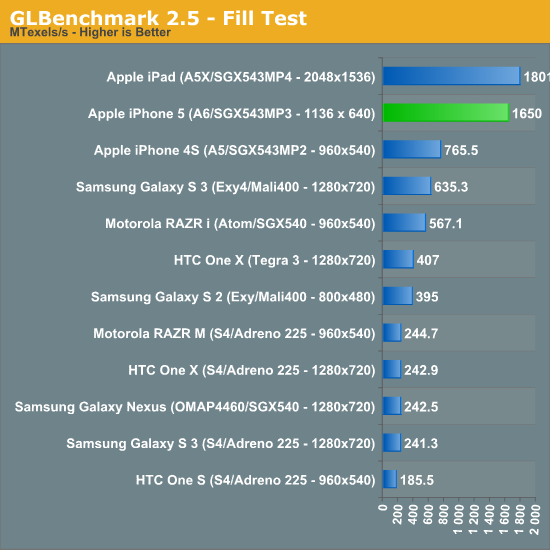
The iPhone 5 nips at the heels of the 3rd generation iPad here, at 1.65GTexels/s. The performance advantage over the iPhone 4S is more than double, and even the Galaxy S 3 can't come close.
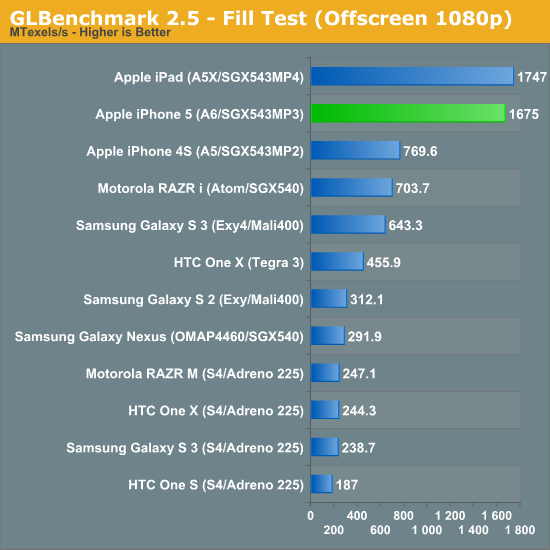
Triangle throughput is similarly strong:

Take resolution into account and the iPhone 5 is actually faster than the new iPad, but normalize for resolution using GLBenchmark's offscreen mode and the A5X and A6 look identical:
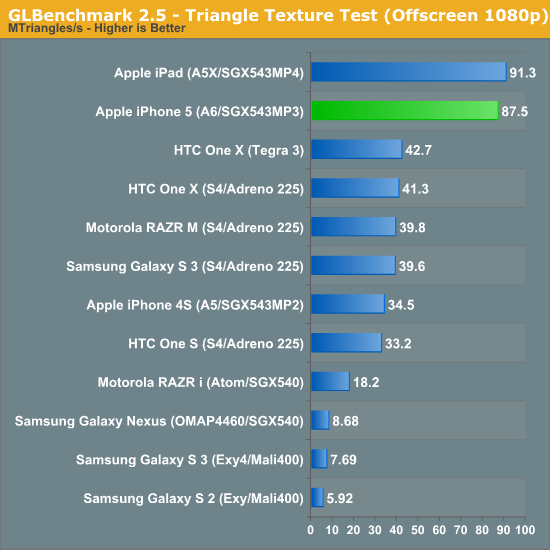
The fragment lit texture test does very well on the iPhone 5, once again when you take into account the much lower resolution of the 5's display performance is significantly better than on the iPad:
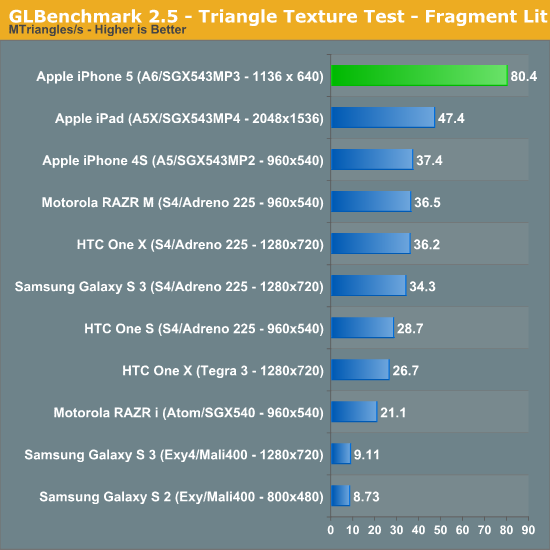
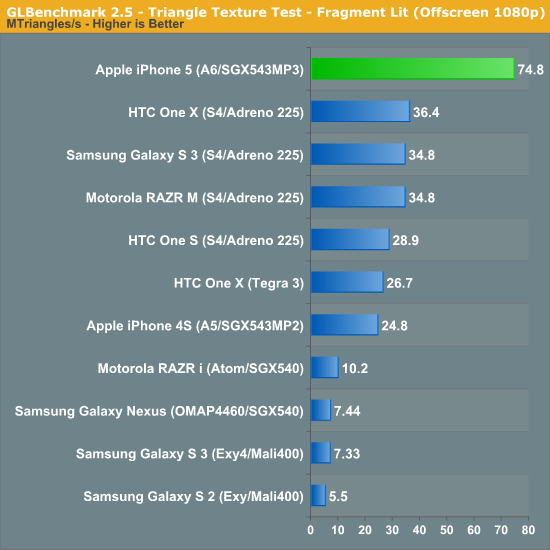

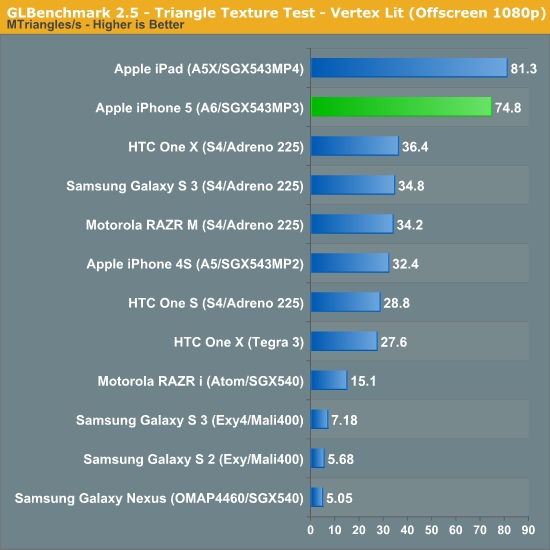
The next set of results are the gameplay simulation tests, which attempt to give you an idea of what game performance based on Kishonti's engine would look like. These tests tend to be compute monsters, so they'll make a great stress test for the iPhone 5's new GPU:
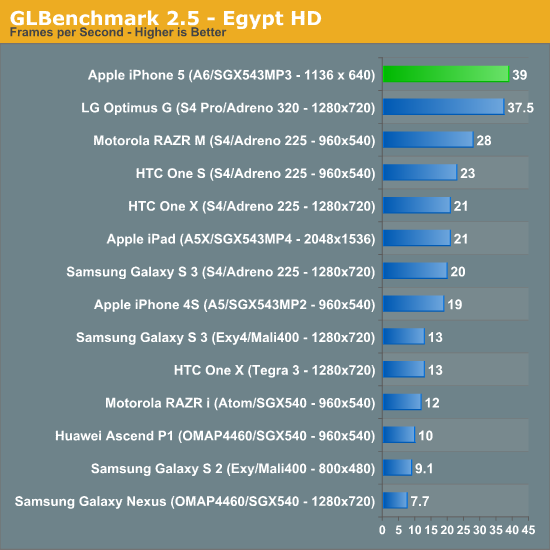
Egypt HD was the great equalizer when we first met it, but the iPhone 5 does very well here. The biggest surprise however is just how well the Qualcomm Snapdragon S4 Pro with Adreno 320 GPU does by comparison. LG's Optimus G, a device Brian flew to Seoul, South Korea to benchmark, is hot on the heels of the new iPhone.
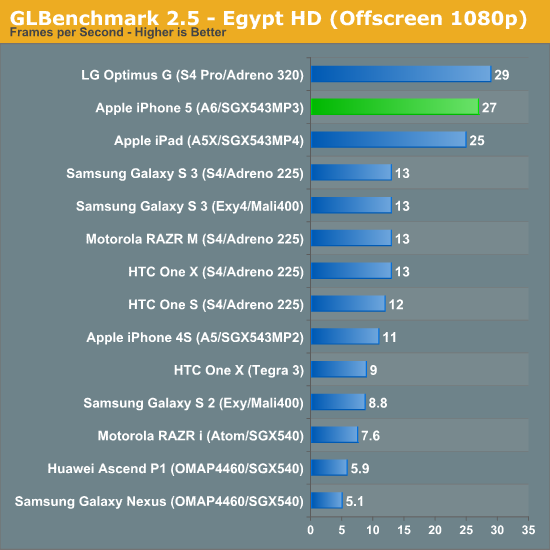
When we run everything at 1080p the iPhone 5 looks a lot like the new iPad, and is about 2x the performance of the Galaxy S 3. Here, LG's Optimus G actually outperforms the iPhone 5! It looks like Qualcomm's Adreno 320 is quite competent in a phone. Note just how bad Intel's Atom Z2460 is, the PowerVR SGX 540 is simply unacceptable for a modern high-end SoC. I hope Intel's slow warming up to integrating fast GPUs on die doesn't plague its mobile SoC lineup for much longer.
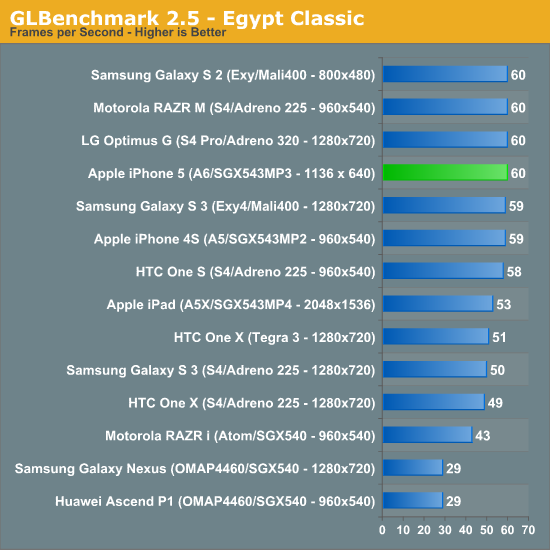
The Egypt classic tests are much lighter workloads and are likely a good indication of the type of performance you can expect from many games today available on the app store. At its native resolution, the iPhone 5 has no problems hitting the 60 fps vsync limit.
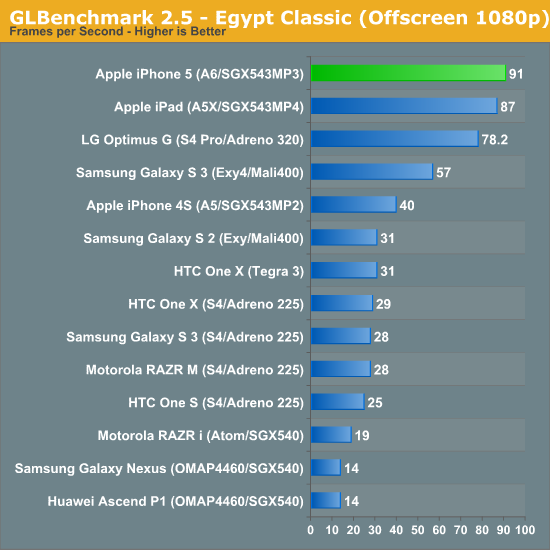
Remove vsync, render at 1080p and you see what the GPUs can really do. Here the iPhone 5 pulls ahead of the Adreno 320 based LG Optimus G and even slightly ahead of the new iPad.
Once again, looking at GLBenchmark's on-screen and offscreen Egypt tests we can get a good idea of how the iPhone 5 measures up to Apple's claims of 2x the GPU performance of the iPhone 4S:
Removing the clearly vsync limited result from the on-screen Egypt Classic test, the iPhone 5 performs about 2.26x the speed of the 4S. If we include that result in the average you're still looking at a 1.95x average. As we've seen in the past, these gains don't typically translate into dramatically higher frame rates in games, but games with better visual quality instead.











276 Comments
View All Comments
TrackSmart - Wednesday, October 17, 2012 - link
Shouldn't the battery life on the Verizon Galaxy SIII with LTE be higher than shown? That result bunches up with the 3G scores rather than the LTE scores. I wonder if the "LTE" listing is a typo.It's also a bit surprising how much of a difference the connection speed makes (3G vs 4G LTE) for the battery life tests. Are you guys really testing differences in power efficiency under typical use? Or have you, inadvertently, created a strange test of air interface throughput/watt - which would vary based on signal strength and network speed, but not based on the main device power draw under typical browsing (i.e. screen + intermittent CPU usage spikes).
I would have guessed that that screen power draw would be the largest cause for differences between handsets, not the air interfaces on the new devices, now that LTE is no longer a power hog.
phillyry - Sunday, October 21, 2012 - link
If it's anything like the Telus GS3 up here in Canada than it's not likely a typo. My brother has it and it tanks so bad on LTE that he keeps it turned off. Same thing with NFC btw. Two major selling features of the GS3 that went down the tubes in reality.Skidmarks - Wednesday, October 17, 2012 - link
I've got to hand it to Apple, if nothing else they sure know to market their rubbish.Freakie - Wednesday, October 17, 2012 - link
I haven't seen the 5 in person, but every time I see a picture of the front of it, I swear its design echos Samsung devices quite a bit. If any light hits it directly then it looks off-black, at least in the pictures, to the point of looking like Samsung's Pebble Blue color back when it was a bit darker (Samsung Impression).They got rid of the band around the phone and just have a slanted surface which when looking at pictures taken 8 inches away from the phone, has it's sharp "edges" that it slants to become one smooth transition. Reminds me a lot of the GSII's front.
Now I'm not a fan of any design litigations going either way, but I've never seen a Samsung device echo the looks of Apple's devices quite as much as the iPhone 5 echos a number of Samsung's design flairs that they've been using for a while.
Just my two cents xP
kmmatney - Wednesday, October 17, 2012 - link
Are you kidding me. Look at how much the original; Samsung Galaxy copies the iPhone 3G. Same with the Galaxy SII.See for yourself
3G versus SGI
https://encrypted-tbn1.gstatic.com/images?q=tbn:AN...
and 4S versus SGII
http://www.gizmowatch.com/entry/comparing-mights-i...
medi01 - Wednesday, October 17, 2012 - link
Wow, SGII and 4S have the same screen ratio, you shameless iScum...Freakie - Wednesday, October 17, 2012 - link
Oh I never said that Samsung hasn't produced a phone similar to an iPhone, though your second picture is pretty ridiculous (that's the SGI not SGII) which came out several months before the 4. Not only that but the picture its self is most definitely shot/edited in a way to make them as similar as possible.My complaint is just Apple doing something very different than normal, and echoing someone else for a change. Usually they seem to go for something different than the rest and the iPhone 5 most definitely does not come anywhere near that.
steven75 - Wednesday, October 17, 2012 - link
This is probably the most silly comment I've read among any iPhone reviews. iPhones have always been similar overall since the revolution if 2007 and now you are seriously making the claim this looks more like a Samsung device?/smh
MNSoils - Wednesday, October 17, 2012 - link
Apple has an interesting story here and your group did a wonderful job telling it.On the 2 graph of the "Increased Dynamic Range" page, the idle power for the Tegra 3 SOC after finishing the Kraken benchmark seems awfully high for just the companion core. Does more time have to elapse before Android reverts to the companion core? Is the companion core not that power efficient (power-gated, etc.)? Does Android revert to the companion core?
colonelclaw - Wednesday, October 17, 2012 - link
Thanks for a terrific article. It's just a shame that about 75% of the comments will be by people who either love the device or hate it, and nothing in this carefully researched and written appraisal will make them change their minds either way.How did we get to this? Actually, don't answer, that would turn into an irrelevant pissing match too.